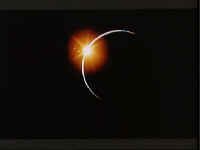|
||||||
Eclipse of the sun
Why, when and where?
 A solar eclipse occurs when the orbit of the new moon passes between the sun and the earth. Since there is a new moon every 29.5 days then there are thirteen potential chances per year of this occurring. But the moon also has to be in the daylight and half the new moons occur when the moon is in the night sky; the chances are reduced to about six chances per year. However, the moon's orbit is tilted so that it is not always in a direct path between the sun and the earth. So unless you are in space above the earth the eclipse will not be seen on planet earth. In reality there is usually between 2 and 4 solar eclipses per year. Most year's only have 2 eclipses.
A solar eclipse occurs when the orbit of the new moon passes between the sun and the earth. Since there is a new moon every 29.5 days then there are thirteen potential chances per year of this occurring. But the moon also has to be in the daylight and half the new moons occur when the moon is in the night sky; the chances are reduced to about six chances per year. However, the moon's orbit is tilted so that it is not always in a direct path between the sun and the earth. So unless you are in space above the earth the eclipse will not be seen on planet earth. In reality there is usually between 2 and 4 solar eclipses per year. Most year's only have 2 eclipses.
Eclipses are of three main types:
- TOTAL - The moon total obscures the sun and casts a dark shadow on part of the earth.
- ANNULAR - The moon comes directly between the earth and the sun and could be regarded as a total eclipse but the moon is too small to completely obscure (or eclipse) the sun. This is because the moon is at it furthest distance from the Earth. At this point of its orbit the moon appears to be slightly smaller (some 13%) than the sun and cannot completely obscure it.
- PARTIAL - The moon only partially comes between the Earth and the Sun. A partial eclipse can be seen from parts of the earth to the north and south of the path of totality of a total eclipse.
Each type of eclipse happens approximately in a third of all cases.
Total eclipse of the sun
Total eclipses are the most special since they completely block out the sun; with the other types since the sunlight is only partially obscured most observers on earth wouldn't notice it.
The dynamics of the solar system are such that the moon appears to be the same size as the sun. In fact the sun is some 400 times bigger than the moon but is 400 times further away. So the moon is able to completely block out the sun.
|
To demonstrate the effect take 2 pieces of paper of the same size; fold one in half and place it in front of the larger piece of paper such that it obscures it completely. If you measure the distances you will see that the distance between you and the larger paper is two times (twice) the distance to the smaller smaller paper. |
The eclipse might also be obscured by clouds or occur on the horizon so that it is not visible. It can also occur in obscure regions of the Earth; across the Pacific Ocean or Antarctica for instance.
For every place on earth there is less than one chance per life-time to see the majesty of a total eclipse of the sun. If you get that chance DO NOT MISS IT.
The size of the shadow the moon casts on the earth can also vary enormously. On 23 November 2003 it will be 495 km (c 310 miles) wide but on 4 December 2002 it will only be 87km (62 miles) wide.
The time of "totality" can also vary widely. On 23 November 2003 it will only last for 1 minute 57 seconds yet on 22 July 2009 it will last up to 6 minutes 39 seconds. This will be the longest eclipse in the 21st century (the shortest will last for only 8 seconds on 6 December 2067!)
NASA: to this and other solar eclipses.
Fred Espenak's of NASA Goddard Space Flight Center "All you ever need to know about solar eclipses on "
IMPORTANT>>> <<<IMPORTANT
Fred Espenak of NASA
ADVICE FROMNever look at the Sun with any kind of telescope or binoculars. You could easily blind yourself. It is even dangerous to look at the fully bright Sun with the naked-eyeAlthough it is completely safe to look at the Sun during the few minutes of total eclipse itself, partial eclipses, or the partial phase of a total eclipse, should not be viewed without protecting your eyes. Even with 99% of the Sun obscured, the remaining crescent is intensely bright and may cause blindness. The Sun may be safely viewed through special filters or eclipse glasses.Take advice on ways for you and your family to observe the eclipse safely. |
| Advertisement |